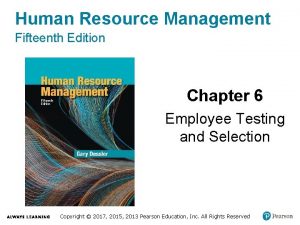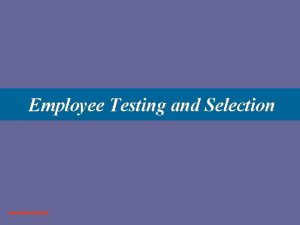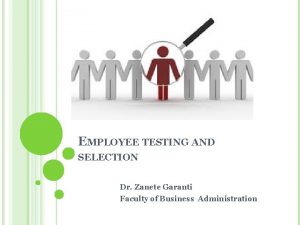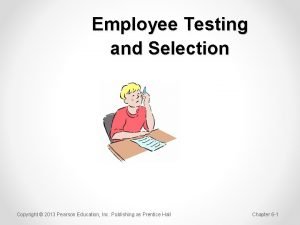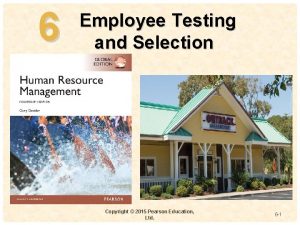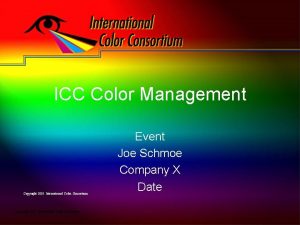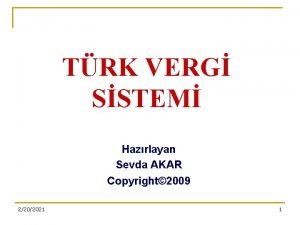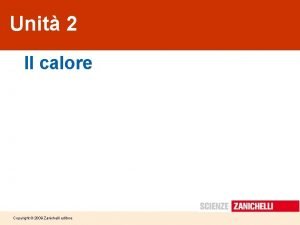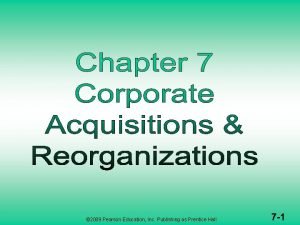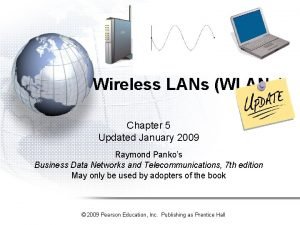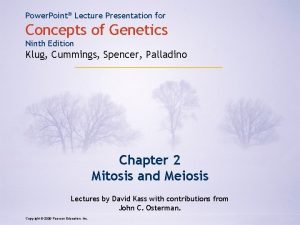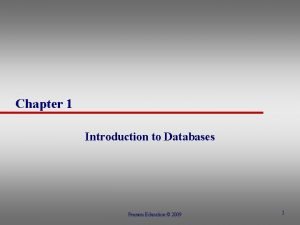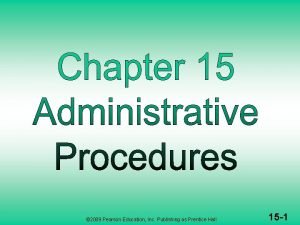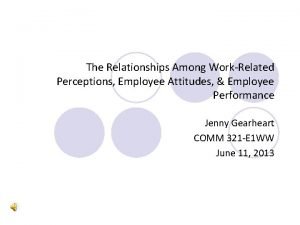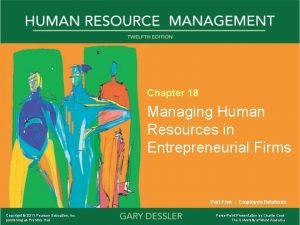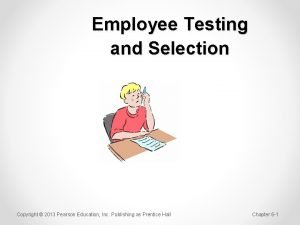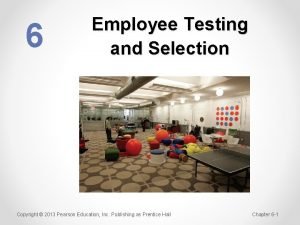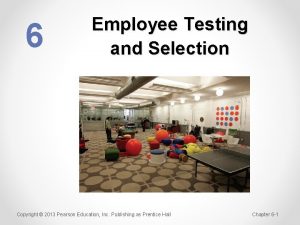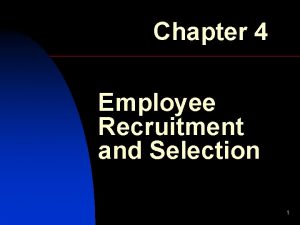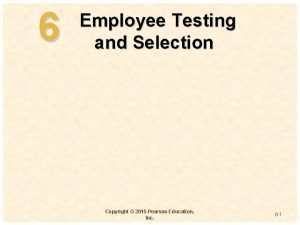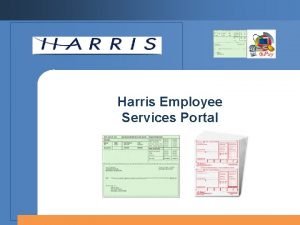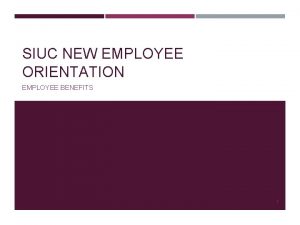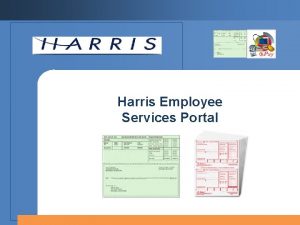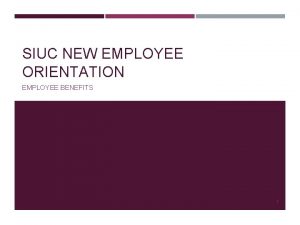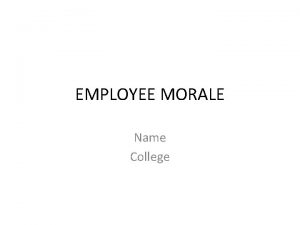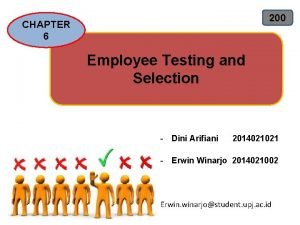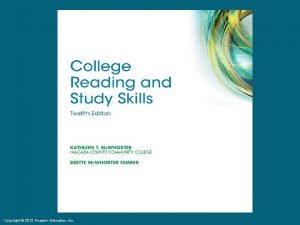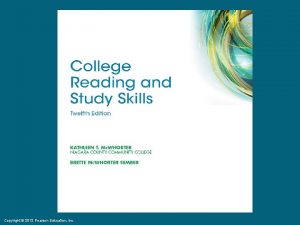Employee testing Selection Chapter 6 Copyright 2009 Pearson























































- Slides: 55

Employee testing & Selection Chapter 6 Copyright © 2009 Pearson Education, Inc. publishing as Prentice Hall 1

The Basics of Testing and Selecting Employees Carefully testing and screening employees is important because – It results in improved employee and organizational performance – Your own performance always depends on subordinates – Can reduce dysfunctional behaviors at work – Effective screening helps reduce costs in the long run Copyright © 2009 Pearson Education, Inc. publishing as Prentice Hall 2

Legal Implications and Negligent Hiring • Incompetent hiring can result in legal implications such as unfairly discriminating against a protected group Copyright © 2009 Pearson Education, Inc. publishing as Prentice Hall 3

Legal Implications and Negligent Hiring, cont. • Negligent hiring occurs when employers are liable for employees who have criminal records or other problems that use a customer’s home or similar opportunities to commit crimes – Hiring these types of employees requires safeguards – Reasonable action must be taken to investigate the candidate’s backgrounds Copyright © 2009 Pearson Education, Inc. publishing as Prentice Hall 4

Testing for Reliability • Reliability is the consistency of scores obtained by the same person when retested with the identical test or an equivalent form of the test – Retest estimate compares two test scores taken by the same individual at different times – Equivalent-form estimate compares the original test with a different but equivalent test taken by the same individual at a different time Copyright © 2009 Pearson Education, Inc. publishing as Prentice Hall 5

– Internal comparison estimates look at question groupings to statistically analyze the degree to which responses to this group vary together Copyright © 2009 Pearson Education, Inc. publishing as Prentice Hall 6

Testing and Validity • Test validity means that the test is measuring what it is supposed to measure • Validity often refers to evidence the test is jobrelated and test performance is a valid predictor of job performance • Two measures of validity are criterion validity which means those who do well on the test perform well on the job (and vice versa) and content validity which means the test constitutes a fair sample of the job content Copyright © 2009 Pearson Education, Inc. publishing as Prentice Hall 7

Copyright © 2009 Pearson Education, Inc. publishing as Prentice Hall 8

Individual Rights of Test Takers and Test Security • Test takers have various privacy and information rights • The American Psychological Association’s standards for educational and psychological tests include – The right to confidentiality of results – The right to informed consent regarding use of results Copyright © 2009 Pearson Education, Inc. publishing as Prentice Hall 9

Individual Rights of Test Takers and Test Security, cont. – The right to expect only qualified individuals will have access to the results – The right to expect the test is secure Copyright © 2009 Pearson Education, Inc. publishing as Prentice Hall 10

Using Tests as Supplements • Do not use tests as your only selection method - use tests to supplement other methods like interviews and background checks • Remember that tests are not infallible • Most tests are more predicative at identifying candidates that will likely fail rather than succeed Copyright © 2009 Pearson Education, Inc. publishing as Prentice Hall 11

Using Tests at Work • Employers have long used tests to predict behavior and performance • Example: Are you prone to on-the-job accidents? Copyright © 2009 Pearson Education, Inc. publishing as Prentice Hall 12

Copyright © 2009 Pearson Education, Inc. publishing as Prentice Hall 13

How Are Tests Used at Work? • Online and off-line computerized tests or aptitude tests could be used to measure a wide range of candidate attributes including: • Cognitive abilities • Motor and physical abilities • Personality and interests • Achievement Copyright © 2009 Pearson Education, Inc. publishing as Prentice Hall 14

Tests of Cognitive Abilities • Employers often assess a candidate’s cognitive or mental abilities, for example: Is the bookkeeping candidate good with numbers? • Intelligence or IQ tests look at general intellectual abilities including memory, vocabulary, verbal fluency and numeric ability • Aptitude tests measure specific mental abilities Copyright © 2009 Pearson Education, Inc. publishing as Prentice Hall 15

Copyright © 2009 Pearson Education, Inc. publishing as Prentice Hall 16

Tests of Motor and Physical Abilities • Motor or physical abilities might need to be measured for specific jobs – Finger dexterity – Strength – Manual dexterity – Reaction time – Speed of finger, hand or arm movements Copyright © 2009 Pearson Education, Inc. publishing as Prentice Hall 17

Measuring Personality • Personality tests and interest inventories measure and predict intangibles such as attitude, motivation and temperament • A sample personality item: It does not make sense to work hard on something if no one will notice: A. Definitely true B. Somewhat true C. Neither true nor false D. Somewhat false E. Definitely false Copyright © 2009 Pearson Education, Inc. publishing as Prentice Hall 18

Personality Test Effectiveness • Difficulties notwithstanding – studies confirm that personality tests can help companies hire more effective workers • Measure relationships between the five personality dimensions below with job performance criteria: – Extroversion – Emotional stability Copyright © 2009 Pearson Education, Inc. publishing as Prentice Hall 19

Personality Test Effectiveness, cont. – Agreeableness – Conscientiousness – Openness to experience Copyright © 2009 Pearson Education, Inc. publishing as Prentice Hall 20

Interest Inventories and Achievement Tests • Interest inventories compare one’s interests with those of people in various occupations • Achievement tests basically measure what a person has learned Copyright © 2009 Pearson Education, Inc. publishing as Prentice Hall 21

Computerized and Online Testing • Replacing conventional paperand-pencil and manual tests • Computerized tests usually score individuals the same as manual tests Copyright © 2009 Pearson Education, Inc. publishing as Prentice Hall 22

Management Assessment Centers • In a Management Assessment Center management candidates take tests and make decisions in simulated situations while observers score their performance • Average time at center is usually 2 or 3 days and involves 10 to 12 candidates Copyright © 2009 Pearson Education, Inc. publishing as Prentice Hall 23

Management Assessment Centers, cont. Examples of simulated realistic exercises include: – The in-basket creates a situation where the candidate is faced with an accumulation of reports, memos, phone messages, letters, etc. , of the simulated job he or she is to take over while being evaluated on what action he or she takes for each of these materials Copyright © 2009 Pearson Education, Inc. publishing as Prentice Hall 24

Management Assessment Centers, cont. – The leaderless group discussion occurs when a leaderless group is given a discussion question and told to arrive at a group decision while observers evaluate leadership ability, acceptance by group, etc. – Individual presentations used to evaluate a participant’s communication skills and his or her persuasiveness by orally presenting on an assigned topic Copyright © 2009 Pearson Education, Inc. publishing as Prentice Hall 25

Interviewing Candidates • Interviewing is an indispensible management tool • An Interview is a procedure designed to solicit information from a person’s oral responses to oral inquiries • A Selection Interview is designed to predict future job performance based on candidate’s answers Copyright © 2009 Pearson Education, Inc. publishing as Prentice Hall 26

Types of Selection Interviews • Non-structured (questions are asked as you think of them) versus structured interviews (questions are known and the order specified in advance) Copyright © 2009 Pearson Education, Inc. publishing as Prentice Hall 27

Types of Selection Interviews, cont. • There are different types of questions for different types of interviews – Situational interviews ask what would the candidate’s behavior be in a given situation – Behavioral interviews ask how the candidate has reacted in a similar situation in the past Copyright © 2009 Pearson Education, Inc. publishing as Prentice Hall 28

Types of Selection Interviews, cont. • Interviews are also classified by how they are administered • One-on-one interviews were two people meet alone and one interviews the other • Sequential interviews occur when several people interview the applicant in sequence before a decision is made Copyright © 2009 Pearson Education, Inc. publishing as Prentice Hall 29

Types of Selection Interviews, cont. • Panel interviews are when the candidate is interviewed simultaneously by a group • Interviews can also occur via video or phone Copyright © 2009 Pearson Education, Inc. publishing as Prentice Hall 30

How Useful Are Interviews? • Statistical evidence regarding validity is mixed indicating that the key to usefulness depends on type of interview employed – When predicting job performance the situational interview yields more accurate results – Structured interviews, regardless of content, are more valid for predicting job performance – One-on-one interviews tend to be more valid than panel interviews Copyright © 2009 Pearson Education, Inc. publishing as Prentice Hall 31

Avoiding Common Interview Mistakes • Do not make snap judgments • Do not emphasize the negative • Make sure you know the job for which you are interviewing the candidate • Do not let the pressure to hire color your opinions Copyright © 2009 Pearson Education, Inc. publishing as Prentice Hall 32

Avoiding Common Interview Mistakes, cont. • Do not allow candidate order (contrast) error to influence the interview • Take into consideration the influence of nonverbal behavior and guard against bias • Remember to look beyond the candidate’s physical attractiveness • Be wary of ingratiating and self-promoting behaviors Copyright © 2009 Pearson Education, Inc. publishing as Prentice Hall 33

Avoiding Common Interview Mistakes, cont. • Prepare and plan for the interview • Establish rapport with the candidate • Ask appropriate questions Copyright © 2009 Pearson Education, Inc. publishing as Prentice Hall 34

Copyright © 2009 Pearson Education, Inc. publishing as Prentice Hall 35

Copyright © 2009 Pearson Education, Inc. publishing as Prentice Hall 36

The Dos and Don’ts of Interview Questions • Don’t ask questions that can be answered “yes” or “no” • Don’t put words in the applicant’s mouth or telegraph the desired answer by nodding or smiling when the right answer is given • Don’t interrogate the applicant as if the person is a criminal Copyright © 2009 Pearson Education, Inc. publishing as Prentice Hall 37

The Do’s and Don’ts of Interview Questions, cont. • Don’t be patronizing, sarcastic or inattentive • Don’t monopolize the interview by rambling nor let the applicant dominate the interview so you can’t ask all your questions • Do ask open-ended questions • Do listen to the candidate to encourage him or her to express thoughts fully Copyright © 2009 Pearson Education, Inc. publishing as Prentice Hall 38

The Do’s and Don'ts of Interview Questions, cont. • Do draw out the applicant’s opinions and feelings by repeating the person’s last comment as a question • Do ask for examples Copyright © 2009 Pearson Education, Inc. publishing as Prentice Hall 39

Closing the Interview • Leave time to answer any questions the candidate may have • If appropriate advocate your firm to the candidate • Try to end the interview on a positive note • Tell the applicant whethere’s interest and what the next step will be • Make rejections diplomatically Copyright © 2009 Pearson Education, Inc. publishing as Prentice Hall 40

Using Other Selection Techniques • Conduct background investigations – Check social networking sites – Talk to current and previous supervisors to discover more about person’s motivation, competence and ability to work with others – Perform credit check or use employment screening services Copyright © 2009 Pearson Education, Inc. publishing as Prentice Hall 41

Using Other Selection Techniques, cont. • Perform reference checks – Make sure the candidate has signed a release – Always get two forms of identification and make applicants fill out job applications – Use a structured reference checking form – Use given references as a source for others – Ask the right questions and judge whether the reference’s answers are evasive Copyright © 2009 Pearson Education, Inc. publishing as Prentice Hall 42

Using Other Selection Techniques, cont. – Ask open-ended questions and listen carefully – Make sure checking references is done by authorized managers – Can be ineffective due to legal repercussions or a current supervisor might give a bad employee a good reference to get rid of the employee Copyright © 2009 Pearson Education, Inc. publishing as Prentice Hall 43

Honesty Testing • The Polygraph or lie-detector is a device that measures physiological changes such as increased perspiration – Results are interpreted assuming that such changes reflect emotional stress – Employee Polygraph Protection Act prohibits most employers from conducting polygraph exams on applicants and most employees Copyright © 2009 Pearson Education, Inc. publishing as Prentice Hall 44

Honesty Testing, cont. • Paper-and-pencil honest tests – Measure attitudes regarding tolerance of others who steal – Acceptance of rationalizations for theft – Admission of theftrelated activities Copyright © 2009 Pearson Education, Inc. publishing as Prentice Hall 45

Spotting Dishonesty • Ask blunt questions • Listen, rather than talk • Ask for a credit check • Check all references • Consider using a paper-and-pencil test • Test for drugs Copyright © 2009 Pearson Education, Inc. publishing as Prentice Hall 46

Spotting Dishonesty, cont. • Conduct searches • Communicate with employees • Use caution Copyright © 2009 Pearson Education, Inc. publishing as Prentice Hall 47

More Steps to Selecting Candidates • Graphology is also known as handwriting analysis and has questionable validity • Physical exams can confirm the applicant qualifies for the physical requirements of the position or possibly detect communicable diseases unknown to the applicant – Must comply with ADA regulations – Only permitted if such exams are standard practice Copyright © 2009 Pearson Education, Inc. publishing as Prentice Hall 48

More Steps to Selecting Candidates, cont. • Drug screening – Commonly done before candidates are formally hired – Many firms test current employees after a work accident or when there are obvious behavioral symptoms – Some companies administer drug tests randomly on a periodic basis – Some firms only administer drug tests when transferring or promoting employees Copyright © 2009 Pearson Education, Inc. publishing as Prentice Hall 49

More Steps to Selecting Candidates, cont. • Problems with drug testing – Doesn’t correlate with actual impairment levels and there are many products that exist to help employees beat drug tests – Some argue drug testing violates employees right to privacy and due process while others feel the procedures are degrading and intrusive – Some say positive results are irrelevant to performing the job Copyright © 2009 Pearson Education, Inc. publishing as Prentice Hall 50

More Steps to Selecting Candidates, cont. • Legal issues with drug screening – Under the Americans with Disabilities Act a court might view a former drug user as a qualified applicant with a disability – Some regulations require testing of workers with sensitive or safety-related jobs Copyright © 2009 Pearson Education, Inc. publishing as Prentice Hall 51

Complying with Immigration Law • The Immigration Reform and Control Act of 1986 requires people to prove that they are eligible to be employed in the United States – Is the candidate a U. S. citizen? – Is the candidate an alien lawfully authorized to work in the U. S. ? Copyright © 2009 Pearson Education, Inc. publishing as Prentice Hall 52

Complying with Immigration Law, cont. There are two basic ways to document compliance – Prospective employees can show their U. S. passport or alien registration card proving both identity and employment eligibility – Prospective employees can show a separate documents that prove identity and show employment eligibility, i. e. a work permit Copyright © 2009 Pearson Education, Inc. publishing as Prentice Hall 53

Evaluating the Selection Process Copyright © 2009 Pearson Education, Inc. publishing as Prentice Hall 54

All rights reserved. No part of this publication may be reproduced, stored in a retrieval system, or transmitted, in any form or by any means, electronic, mechanical, photocopying, recording, or otherwise, without the prior written permission of the publisher. Printed in the United States of America. Copyright © 2009 Pearson Education, Inc. publishing as Prentice Hall 55
 Copyright 2009
Copyright 2009 Copyright 2009 pearson education inc
Copyright 2009 pearson education inc Copyright 2009 pearson education inc
Copyright 2009 pearson education inc 2009 pearson education inc
2009 pearson education inc 2009 pearson education inc
2009 pearson education inc Copyright 2009 pearson education inc
Copyright 2009 pearson education inc Chapter 6 employee testing and selection ppt
Chapter 6 employee testing and selection ppt Employee testing and selection
Employee testing and selection Employee testing and selection summary
Employee testing and selection summary 2013 pearson education inc. answers
2013 pearson education inc. answers Employee testing and selection
Employee testing and selection Copyright international color consortium, 2009
Copyright international color consortium, 2009 Dell all rights reserved copyright 2009
Dell all rights reserved copyright 2009 Diffrazione della luce zanichelli
Diffrazione della luce zanichelli Copyright 2009
Copyright 2009 Capacita termica
Capacita termica 2009 pearson education inc
2009 pearson education inc 2009 pearson education inc
2009 pearson education inc 2009 pearson education inc
2009 pearson education inc Pearson 2009
Pearson 2009 Pearson 2009
Pearson 2009 Pearson 2009
Pearson 2009 Pearson education 2009
Pearson education 2009 2009 pearson education inc
2009 pearson education inc 2009 pearson education inc
2009 pearson education inc Employee attitudes and employee performance
Employee attitudes and employee performance 2017 pearson education inc
2017 pearson education inc Copyright pearson education inc
Copyright pearson education inc Copyright 2010 pearson education inc
Copyright 2010 pearson education inc 2018 pearson education inc
2018 pearson education inc Copyright 2014 pearson education inc
Copyright 2014 pearson education inc Copyright 2010 pearson education inc
Copyright 2010 pearson education inc Copyright 2010 pearson education inc
Copyright 2010 pearson education inc Copyright by pearson education inc. answers
Copyright by pearson education inc. answers 2008 pearson education inc
2008 pearson education inc 2005 pearson prentice hall inc
2005 pearson prentice hall inc Copyright pearson education inc
Copyright pearson education inc Copyright 2010 pearson education inc
Copyright 2010 pearson education inc Copyright 2010 pearson education inc
Copyright 2010 pearson education inc Copyright 2010 pearson education inc
Copyright 2010 pearson education inc Copyright 2010 pearson education inc
Copyright 2010 pearson education inc Copyright 2010 pearson education inc
Copyright 2010 pearson education inc Copyright 2010 pearson education inc
Copyright 2010 pearson education inc Copyright 2010 pearson education inc
Copyright 2010 pearson education inc Copyright pearson education inc
Copyright pearson education inc Employee selection
Employee selection Employee selection
Employee selection Pearson education inc publishing as pearson prentice hall
Pearson education inc publishing as pearson prentice hall Pearson education inc publishing as pearson prentice hall
Pearson education inc publishing as pearson prentice hall Educational pearson pearson times
Educational pearson pearson times Stress management for life 5th edition
Stress management for life 5th edition Pearson education inc publishing as pearson prentice hall
Pearson education inc publishing as pearson prentice hall Pearson education inc. 2012
Pearson education inc. 2012 Copyright 2008
Copyright 2008 Balancing selection vs stabilizing selection
Balancing selection vs stabilizing selection Similarities
Similarities






